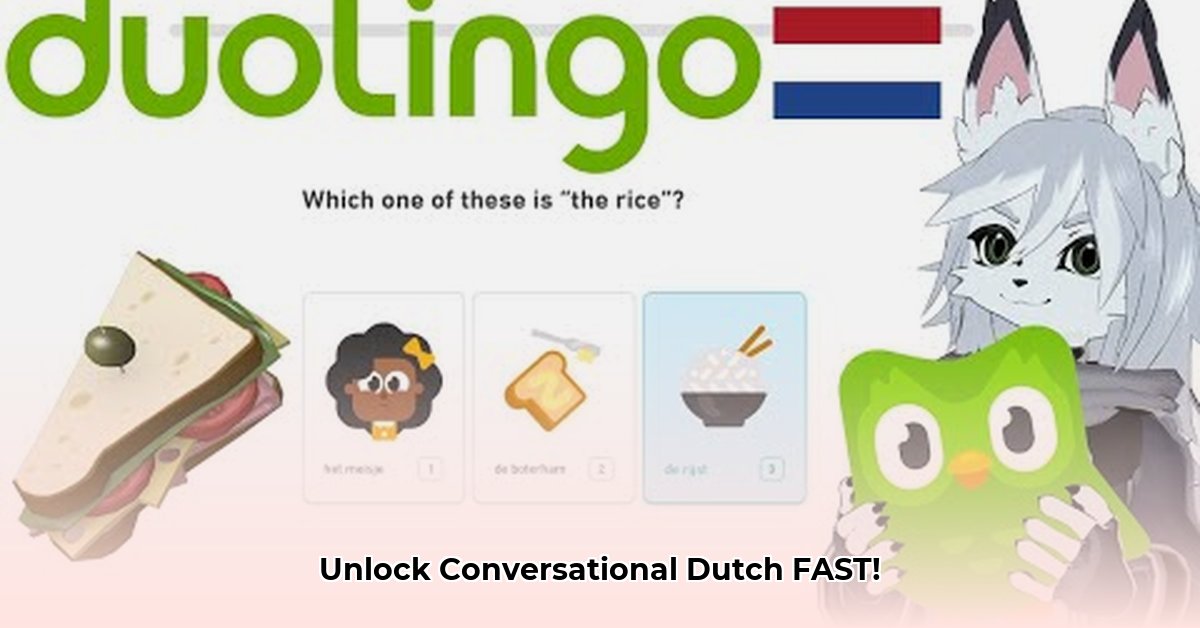
Duolingo Dutch: A Comprehensive Review and Actionable Advice
So, you're dreaming of flawlessly ordering stroopwafels in Amsterdam or effortlessly chatting with friends in Haarlem? Duolingo's Dutch course is a popular starting point, but is it the golden ticket to fluency? This review dissects the app's strengths and weaknesses, providing actionable advice to maximize your learning journey, whether you're a complete beginner or already possess some Dutch knowledge. We'll explore how to leverage Duolingo effectively and what supplementary methods are essential to achieve conversational competence.
Duolingo's Dutch Course: The Positives
Duolingo cleverly employs gamification – points, levels, daily streaks – to maintain motivation. This is particularly beneficial for beginners, making learning feel engaging and rewarding. The user-friendly interface and structured lessons build confidence as you progress, crucial for long-term commitment. The app excels at building a strong foundation in vocabulary and reading comprehension, using repetition and spaced repetition techniques to reinforce learning. But is this enough? Many users find themselves quickly mastering the initial content, leaving them wanting more.
Where Duolingo Dutch Falls Short
While Duolingo provides a solid introduction, several limitations hinder its effectiveness as a standalone solution. The limited content depth is a significant drawback. The course feels somewhat superficial compared to other Duolingo language offerings, leaving learners wanting more advanced material. Another key issue is the inconsistency between the mobile app and desktop versions. Essential grammar explanations often disappear on the mobile app, necessitating a switch to the desktop version—a frustrating interruption for those who prefer mobile learning.
Perhaps the most glaring weakness is the inadequate speaking practice. While the app provides opportunities to pronounce words and phrases, it lacks authentic conversational scenarios, hindering the development of fluency. This makes Duolingo a great supplemental tool, but not a sufficient tool for improving your ability to speak fluent Dutch. How can you overcome such limitations? Let's explore practical strategies to bolster your Dutch skills.
Level Up Your Dutch: Actionable Steps for Success
To truly master Dutch, a multifaceted approach beyond Duolingo is necessary. The following steps will significantly accelerate your progress, regardless of your current level:
For Beginners:
- Maximize Gamification: Fully utilize Duolingo's gamified system. Set daily goals, track your progress, and celebrate milestones. This sustained engagement is key to initial success.
- Diversify Learning Resources: Supplement Duolingo with additional resources like textbooks, online courses (consider Memrise or Babbel as alternatives), or language exchange partners. A balanced approach provides a broader understanding.
- Practice All Four Skills: While Duolingo is strong in reading and listening, actively practice speaking and writing through conversations, journaling in Dutch, and other external resources.
For Intermediate and Advanced Learners:
- Targeted Vocabulary Expansion: Use Duolingo to review and solidify existing knowledge, focusing on areas needing improvement. Use it to supplement and reinforce but not as your primary resource.
- Seek Advanced Resources: Duolingo’s limitations become more apparent at intermediate levels. Explore immersion experiences, such as consuming Dutch media (news, podcasts, movies), interacting with native speakers, or even taking formal language courses.
- Set Specific, Measurable Goals: Move beyond vague aspirations. Define achievable targets like ordering food in Dutch, understanding news broadcasts, or engaging in basic conversations.
The Verdict: Is Duolingo Dutch Worth It?
Duolingo Dutch is a valuable starting point, particularly for beginners. Its gamified approach and intuitive design lower the barrier to entry, making language learning accessible and fun. However, its limitations in content depth, mobile app consistency, and speaking practice necessitate a supportive learning strategy. It's a fantastic tool for initiating your journey, but achieving fluency requires a more comprehensive approach.
Supplementing Duolingo for Conversational Fluency: A Step-by-Step Guide
Bridging the Gap: From App to Fluency
Duolingo's strengths lie in vocabulary acquisition and basic grammar. However, it lacks the depth and contextual richness needed for conversational fluency. This section outlines a structured plan to enhance your skills:
Step 1: Focus on Grammar: Supplement Duolingo with a dedicated grammar textbook or online course. Thorough understanding of grammar is crucial for constructing grammatically correct and nuanced sentences.
Step 2: Prioritize Conversation: Actively seek opportunities for conversational practice. Language exchange partners (HelloTalk, Tandem), online tutors (italki), or local language meetups offer invaluable real-world interaction.
Step 3: Immerse Yourself: Consume Dutch media (movies, music, podcasts, news). Surrounding yourself with the language cultivates a deeper understanding of its natural rhythm and cultural context.
Step 4: Consistent Review and Recall: Utilize flashcards, spaced repetition software (Anki), or other memory-enhancing techniques to regularly review vocabulary and grammar.
Step 5: Set Realistic Expectations: Fluency takes time and dedication. Celebrate progress, adapt your approach as needed, and maintain consistent effort.
Duolingo: Part of a Holistic Approach
Duolingo serves as a strong foundation, but it's not a standalone solution. To reach conversational fluency in Dutch, consistent practice encompassing diverse learning methods is paramount. Remember, language learning should be an enjoyable journey—experiment and adapt your strategy to find what works best for you.
⭐⭐⭐⭐☆ (4.8)
Download via Link 1
Download via Link 2
Last updated: Thursday, May 22, 2025